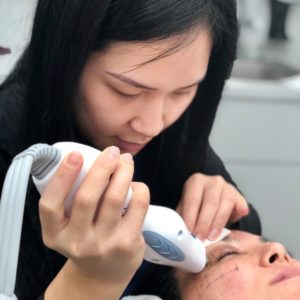LESS LAX: SKIN TIGHTENING
Most of my patients ask how they can tighten their skin without going under the knife to do so. The good news is we have the tools to combat laxity with non-invasive technologies.
Aging of the skin starts the moment we are born but can become obvious in some people starting in their 20s. As we age things change – the skin can become less smooth, pores may become more apparent and skin pigmentation in the form of brown spots appear. With time, other changes occur deeper in the facial skin – fat shrinks, and bone resorbs. These changes make the person look tired, sad and even angry. Further, both on and off the face changes in the collagen and the elastic tissue in the skin develop. These changes in collagen and elastic fibres occur most often as a result of excessive sun exposure but they can also be caused by other things as well: smoking, environmental pollutants, some medications, hormonal changes that occur with menopause and genetics.
Fortunately, we have several tools at our disposal to help correct many of these events. For uneven skin texture we have topical agents such as vitamin A derivatives (retinoids) and glycolic peels that can help to smooth the skin and reduce some types of pigment irregularities. We also use a number of different lasers to correct these changes in a much quicker fashion – often evident within a few weeks.
To reverse the appearance of tiredness, deep circles under the eyes and a downward turning mouth (all the result of volume loss in the facial structures), we utilize a number of different fillers. These agents plump the skin, last for up to a few years and provide for a natural and healthy appearance.
What is the latest in skin tightening?
There is a new second-generation Thermage device in the pipeline, but we are still awaiting Health Canada approval.
I mentioned previously that collagen and elastic tissue also change with time. Their loss or deterioration can result in loose skin that has “crepey” or saggy appearance. On the face it is recognized as loose skin around the eyes or on the lower face and neck as a blunting of the jawline and skin of the neck or elsewhere that doesn’t “spring back” when pinched and released.
What can we do about these changes? Surgery in the form of a face or neck lift helps to tighten the skin by removing excess skin, but it does not have any direct effect on the collagen or elastic tissues themselves. Topical agents have a mild effect at best and many skin care products that claim they can restore youthful skin by building collagen and elastin are kidding you.
Is there anything that can help to reverse the trend? In fact, there are at least a number of devices that can help – though none of them can provide a 100% guarantee of restoring youth. The two main areas of interest revolve around Radio Frequency (RF) or High Intensity Focused Ultrasound (HIFU) skin tightening. With regards to the former, there are a number of different devices out there – monopolar, bipolar, tripolar, micro needling, etc.
How does Thermage tighten skin?
All RF devices revolve around the concept that RF heats water molecules through vibration, and this vibration induces new collagen and elastin formation along with skin tightening. Our preference is to use Thermage RF. Why? Thermage has been around the longest and there is a lot of published scientific evidence to support its claims – and results.

Am I a candidate for skin tightening?
Patients we consider as good candidates for Thermage are those looking to help curb skin laxity before it sets in or improve noticeable laxity that has already started. Most of our patients ages range from 30 years and up, with some of our older patients ranging into their 70s! Additionally, since Thermage uses Radio Frequency, it can be used on any skin type/colour. The only patients we are unable to treat are those with cardiac pacemakers and other active implantation devices, or those who are pregnant or breast feeding. Within the first month after treatment, you should notice a subtle improvement in the laxity of your skin. However, results will continue to show over the next 3-6 months as your body produces new collagen and elastin. These results can be long lasting but generally an annual re-treatment keeps things in top shape.
Other Skin tightening devices and how they compare
Recently, a lot has been said about Ulthera, a HIFU device. It is an effective skin tightening treatment and can be used on the face and neck to reduce laxity and some sagging. However, this procedure is more painful than Thermage and there is slight risk of temporary nerve injury. Both Ulthera and Thermage can be used on other parts of the body – with variable success, but only Thermage can be used around the eyes to help reduce droopy skin that results in a tired and aged appearance.
Earlier this year, the first head to head study comparing Ulthera to Thermage was reported. There were no statistical differences between the two devices in standardized investigator measures of face and neck laxity, patient satisfaction, and adverse events. So how do you choose? Go with a clinic that has board certified Dermatologists and extensive experience.
Downtime and Recovery
The procedure takes about 1.5 hours and there is no downtime after the treatment. Results can be long lasting but generally an annual re-treatment called vectoring is ideal for maintenance.
Curious about Thermage or other treatments to rejuvenate your skin? Contact our office and book a consultation with one of our cosmetic dermatologists.